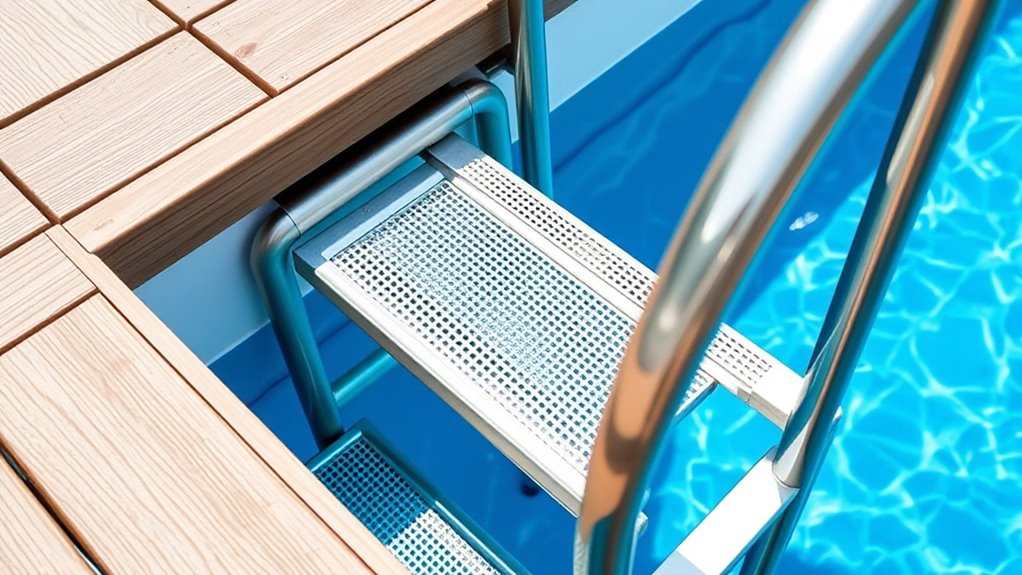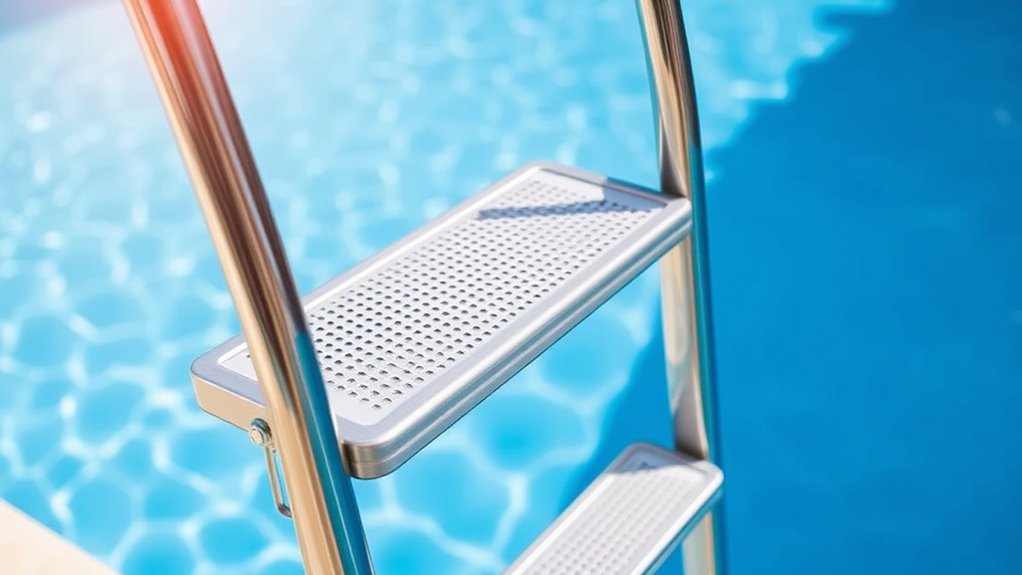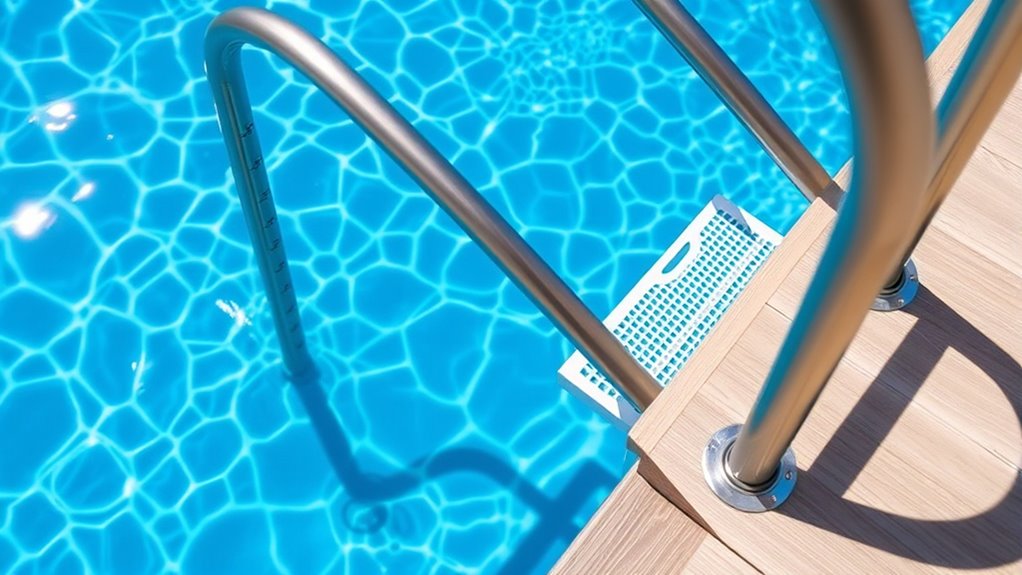To choose the right pool ladder, you’ll need to measure both your pool’s depth and deck height accurately. Shallow pools need shorter, stable ladders, while deeper pools require longer, adjustable options for comfortable access. For decks, measure the distance from the pool edge to the top to determine ladder length. Considering safety features like non-slip steps and sturdy handrails is essential. Keep these tips in mind, and you’ll find the perfect fit—more insights await to help you make the best choice.
Key Takeaways
- Measure your pool’s depth accurately to select a ladder with appropriate tread length and mounting height.
- Determine deck height from the pool edge to choose a ladder with suitable extension or adjustable features.
- Match ladder type—A-frame, wall-mounted, or stairs—to your pool’s design and surrounding deck configuration.
- Prioritize safety features like anti-slip steps, sturdy handrails, and secure locking mechanisms for safe access.
- Follow installation guidelines on level, sturdy surfaces, and regularly inspect for stability and proper fit.
Assessing Your Pool’s Depth and How It Affects Ladder Choice

Your pool’s depth plays a crucial role in choosing the right ladder because it directly affects how safe and easy it is to enter and exit the water. If your pool is shallow, a ladder with shorter steps or a step-over design might be best, providing stability without risking slipping. For deeper pools, you’ll need a ladder with longer treads or a higher mounting point to ensure comfortable access from the deck. Measure the depth accurately at the area where you plan to install the ladder. This helps you select a model that fits securely, preventing wobbling or accidental slipping. Additionally, consider the safety features of the ladder, such as anti-slip steps and secure mounting options, to enhance stability and security. Proper installation and proper maintenance can also extend the lifespan and safety of your ladder. Remember, choosing a ladder that matches your pool’s depth ensures safe, effortless entry and exit, making your swimming experience more enjoyable.
Understanding Deck Height and Its Impact on Ladder Selection

Understanding deck height is essential because it determines how easily you can access your pool with a ladder. If your deck is too high or too low, it affects the ladder’s length and stability. Measure the distance from the pool’s edge to the top of the deck accurately. This measurement guides you in choosing a ladder that fits securely and safely. For example, a ladder that’s too short won’t reach the pool, while one that’s too long may be unsafe. Use the table below to see how deck height influences your choice:
| Deck Height | Suitable Ladder Length |
|---|---|
| 1-2 feet | Shorter, compact ladders |
| 3-4 feet | Standard-sized ladders |
| 5+ feet | Longer, adjustable ladders |
Matching the right ladder to your deck height ensures safe, easy pool access. Considering AI in education advancements, you can even find digital tools that help measure and select the perfect ladder for your specific setup. Proper measurement accuracy is crucial for ensuring safety and optimal fit when selecting a pool ladder. Additionally, understanding vetted safety standards can help you choose a ladder that meets all necessary safety requirements. Being aware of common safety issues associated with pool ladders can further enhance your safety precautions and prevent accidents. Regularly inspecting your ladder for wear and tear also contributes significantly to preventing accidents and ensuring long-term safety.
Types of Pool Ladders and Their Suitability for Different Setups

Choosing the right pool ladder depends on your specific setup and how you plan to use your pool. There are several types to evaluate, each suited for different environments. A standard A-frame ladder is versatile and easy to install, making it ideal for above-ground pools with flat decks. If your pool has a higher deck, a deck-mounted ladder with adjustable steps provides safe, easy access without taking up much space. For in-ground pools, you might prefer a straight or curved ladder that attaches securely to the pool wall. Pool stairs offer an alternative for easier entry, especially for children or those with mobility concerns. Consider your pool’s shape and deck height to choose a ladder that ensures safe, comfortable access tailored to your setup. Incorporating vertical storage solutions can help keep pool accessories organized and easily accessible, enhancing overall safety and convenience. Understanding net+ certification benefits can also be helpful if you’re considering professional advice for pool safety and maintenance. Additionally, selecting a ladder with durable materials ensures longevity and resistance to corrosion in pool environments. Using appropriate safety features like non-slip steps and secure handrails can further improve safety for all users.
Safety Features to Consider for Secure Access

Safety features are essential when selecting a pool ladder to guarantee secure access for all users. Look for non-slip steps that provide good traction, especially when wet. Handrails should be sturdy, easy to grip, and extend above the deck level for stability. Consider ladders with locking mechanisms or self-closing gates to prevent accidental falls, particularly for families with children. Ensure the ladder’s weight capacity matches your pool’s users to avoid accidents. Anti-entrapment features, like wide steps and smooth edges, reduce injury risks. Always check that the ladder is made from corrosion-resistant materials to maintain safety over time. Prioritizing these features helps create a safer swimming environment and minimizes potential accidents during entry and exit.
Installation Tips for Proper Fit and Stability

Proper installation is essential to guarantee your pool ladder fits securely and remains stable during use. First, ensure the mounting surface is level and sturdy. Use a tape measure to confirm the ladder’s placement aligns with your pool’s deck height and depth. Follow the manufacturer’s instructions carefully, tightening all bolts and screws securely without over-tightening. Check that the ladder’s steps are evenly spaced and securely attached. Test stability by gently applying pressure to ensure no movement or wobbling. If your ladder has adjustable features, double-check they’re locked in place. Regularly inspect the installation to ensure everything stays tight and secure over time. Properly installed ladders prevent accidents and give you peace of mind when entering or exiting the pool. Additionally, understanding juice shelf life can help you keep your poolside refreshments fresh for longer, enhancing your overall experience. To further ensure safety, consider essential oil safety precautions, especially if children or pets will be around the pool area.
Frequently Asked Questions
How Do I Measure My Pool’S Exact Depth Accurately?
To measure your pool’s exact depth accurately, grab a long, sturdy measuring stick or tape measure. Carefully lower it straight down into the water at multiple spots, especially the deepest area. Note the deepest point by marking or reading the measurement. Repeat this process at different locations to guarantee consistent readings. This way, you’ll get precise depth information, helping you choose the perfect pool ladder for safety and convenience.
Can I Retrofit an Existing Pool With a New Ladder?
Did you know that over 90% of pool accidents could be prevented with proper safety equipment? You can indeed retrofit an existing pool with a new ladder, but it depends on your pool’s current setup. Measure your deck height and pool depth first, then choose a ladder designed for those dimensions. Ensuring compatibility is key to safe, easy installation and long-term safety.
What Materials Are Best for Corrosion Resistance?
When selecting materials for your pool ladder, focus on corrosion resistance to guarantee longevity. You should opt for stainless steel or aluminum, as they resist rust and withstand exposure to water and chemicals. Plastic or resin options are also good choices, especially in saltwater pools. These materials require less maintenance and won’t degrade quickly, keeping your ladder safe and functional over time.
Are There Adjustable Ladders for Varying Deck Heights?
Yes, adjustable ladders are available for varying deck heights. They let you customize the height to match your pool’s depth and your deck’s elevation, ensuring safer, more comfortable access. You simply adjust the rungs or steps to fit your setup, making installation easier and more flexible. Look for models with sturdy locking mechanisms to keep the ladder securely in place once adjusted.
How Often Should I Inspect My Pool Ladder for Safety?
You should inspect your pool ladder at least once a month to guarantee safety. Look for loose screws, rust, or corrosion, and check the steps and handrails for stability. After heavy use or storms, give it a quick check. Regular inspections prevent accidents and extend the ladder’s lifespan. If you notice any damage or instability, fix or replace parts immediately to keep your pool area safe.
Conclusion
Choosing the right pool ladder ensures safe, easy access and prolongs your pool’s lifespan. Did you know that properly installed ladders can reduce accidents by up to 50%? By evaluating your pool’s depth, deck height, and considering safety features, you’ll make an informed choice. Take your time to select and install the right ladder—it’s an investment in your safety and pool enjoyment. Immerse yourself confidently with the perfect ladder for your setup.










